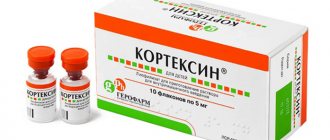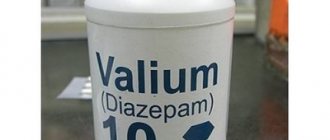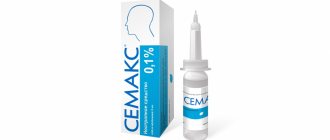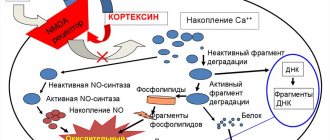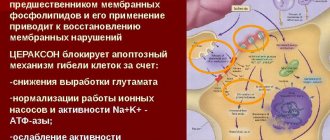Trittico
Use during pregnancy and breastfeeding
The drug is contraindicated for use during pregnancy and lactation (breastfeeding).
Use for liver dysfunction
The drug should be prescribed with caution to patients with liver failure.
Use for renal impairment
The drug should be prescribed with caution to patients with renal failure.
Use in children
The use of the drug in children and adolescents under 18 years of age is contraindicated (the safety of trazodone for children has not been established).
Use in elderly patients
For elderly and debilitated patients, the initial dose is up to 100 mg/day in fractional doses or 1 time/day before bedtime. The dose may be increased under medical supervision, depending on the effectiveness and tolerability of the drug. Usually no dose exceeding 300 mg/day is required.
special instructions
People with depression have an increased risk of suicidal thoughts, self-harm, or suicide. The risk may last until significant remission occurs. Since improvement may not occur for the first few weeks of treatment or more, patients should be closely monitored until such improvement occurs. It is common clinical experience that the risk of suicide may increase in the early stages of recovery. It is known that patients with a history of suicidal events, or patients who exhibit a significant degree of suicidal ideation even before treatment, have a higher risk of suicidal ideation or suicide attempts, and should be closely monitored during treatment. The results of a meta-analysis of placebo-controlled clinical trials of antidepressants used in adults with mental disorders showed an increased risk of suicidal behavior in patients under the age of 24 years while taking antidepressants compared with placebo. Careful monitoring of patients, especially those at high risk, should accompany drug therapy, especially in its early stages and after dose changes. Patients (and their caregivers) should be warned to monitor for any clinical deterioration, suicidal behavior or thoughts, or unusual changes in behavior, and to immediately seek professional advice if such symptoms occur.
Since the drug has some adrenergic blocking activity, bradycardia and a decrease in blood pressure may develop. Therefore, caution should be exercised when prescribing the drug to patients with a tendency to prolong the QT interval, AV block of varying severity, and patients with a recent myocardial infarction.
When treated with trazodone in patients with bipolar disorder, depressive episodes can range from manic-depressive to manic psychosis. In these cases, it is necessary to interrupt treatment.
If you have epilepsy, use trazodone with caution, in particular avoiding sudden increases or decreases in dose.
With simultaneous use of trazodone with drugs that have serotonergic activity (tricyclic antidepressants, selective serotonin reuptake inhibitors, norepinephrine and serotonin reuptake inhibitors and MAO inhibitors) and antipsychotics, serotonin syndrome may occur.
When trazodone is used simultaneously with drugs containing St. John's wort, side effects may be more frequent.
When using trazodone, agranulocytosis may develop, so it is recommended to conduct peripheral blood tests, especially if there is a sore throat when swallowing and fever.
Trazodone is effective for sleep disorders in patients with depression, increases the depth and duration of sleep, and restores its physiological structure and quality.
The use of the drug does not affect body weight.
The drug is not addictive.
Impact on the ability to drive vehicles and operate machinery
During the period of use of the drug, care must be taken when driving vehicles and engaging in other potentially hazardous activities that require increased concentration and speed of psychomotor reactions.
Trittico
Release form, composition and packaging
Controlled-release tablets are white or off-white, oval, with two parallel lines on both sides.
1 tab. trazodone hydrochloride 75 mg.
Excipients: sucrose, carnauba wax, povidone (polyvinylpyrrolidone), magnesium stearate.
Controlled-release tablets are white or off-white, oval, with two parallel lines on both sides.
1 tab. trazodone hydrochloride 150 mg.
Excipients: sucrose, carnauba wax, povidone (polyvinylpyrrolidone), magnesium stearate.
Clinical and pharmacological group: Antidepressant.
pharmachologic effect
Antidepressant. Trazodone, being a triazolopyridine derivative, has a predominantly antidepressant effect, with some sedative and anxiolytic effects. Trazodone has no effect on MAO, which distinguishes it from MAO inhibitors and tricyclic antidepressants.
The mechanism of action of trazodone is associated with the high affinity of the drug for certain subtypes of serotonin receptors, with which trazodone enters into an antagonistic or agonistic interaction depending on the subtype, as well as with the specific ability to cause inhibition of serotonin reuptake.
Quickly affects mental (affective tension, irritability, fear, insomnia) and somatic symptoms of anxiety (palpitations, headache, muscle pain, frequent urination, sweating, hyperventilation).
Trazodone is effective for sleep disorders in patients with depression, increases the depth and duration of sleep, and restores its physiological structure and quality.
Trittico stabilizes the emotional state, improves mood, reduces pathological craving for alcohol in patients suffering from chronic alcoholism during the period of alcohol withdrawal syndrome, also in remission. For withdrawal symptoms in patients suffering from dependence on benzodiazepine derivatives, trazodone is effective in the treatment of anxiety, depression and sleep disorders. During remission, benzodiazepines can be completely replaced by trazodone.
Helps restore libido and potency in both depressed and non-depressed patients.
The drug is not addictive.
The neutral uptake of norepinephrine and dopamine has little effect. Does not affect body weight.
Pharmacokinetics
Suction
Absorption of the drug from the gastrointestinal tract after oral administration is high. Taking trazodone during or immediately after a meal slows down the rate of absorption, reduces Cmax of the drug in blood plasma and increases Tmax. Cmax in blood plasma is achieved 0.5-2 hours after oral administration.
Distribution
Plasma protein binding – 89–95%. Penetrates through histohematic barriers, as well as into tissues and liquids (bile, saliva, breast milk).
Metabolism
Trazodone is metabolized in the liver, the active metabolite is 1-m-chlorophenylpiperazine.
Removal
T1/2 is 3-6 hours, in the second phase - 5-9 hours. Most of the metabolized drug is excreted by the kidneys - about 75%, and is completely completed 98 hours after administration; About 20% is administered with bile.
Indications
- anxiety-depressive states of endogenous nature (including involutional depression);
- psychogenic depression (including reactive and neurotic depression);
- anxiety-depressive states against the background of organic diseases of the central nervous system (dementia, Alzheimer's disease, cerebral atherosclerosis);
- depressive states with prolonged pain syndrome;
- alcoholic depression;
- benzodiazepine dependence;
- libido and potency disorders.
Dosage regimen
The drug is taken orally 30 minutes before meals or 2-4 hours after meals. The prescribed dose of the tablet should be taken whole, without chewing and with a sufficient amount of water.
Adults are prescribed an initial dose of 100 mg 1 time / day after meals before bedtime. On the 4th day you can increase the dose to 150 mg. Subsequently, in order to achieve the optimal therapeutic effect, the dose is increased by 50 mg/day every 3-4 days until the optimal dose is reached. A daily dose of more than 150 mg should be divided into 2 doses, with the smaller dose taken after lunch and the main dose before bedtime.
The maximum daily dose for outpatients is 450 mg.
The maximum daily dose for inpatients is 600 mg. When treating libido disorders, the recommended daily dose is 50 mg.
When treating impotence, in the case of monotherapy with the drug, the recommended daily dose is more than 200 mg, with combination therapy - 50 mg.
When treating benzodiazepine dependence, the recommended treatment regimen is based on a gradual, sometimes over several months, reduction of the benzodiazepine dose. Each time, reducing the dose of benzodiazepine by 1/4 or 1/2 tablet, 50 mg of trazodone is simultaneously added. This ratio is left unchanged for 3 weeks, then a further gradual reduction in the dose of benzodiazepines is started until they are completely discontinued. After this, reduce the daily dose of trazodone by 50 mg every 3 weeks.
For elderly and debilitated patients, the initial dose is up to 100 mg/day in fractional doses or 1 time/day before bedtime. The dose may be increased under medical supervision, depending on the effectiveness and tolerability of the drug. Usually no dose exceeding 300 mg/day is required.
Children aged 6-18 years: initial daily dose of 1.5–2 mg/kg/day, divided into several doses. If necessary, the dose is gradually increased to 6 mg/kg/day at intervals of 3-4 days.
Side effect
From the central nervous system and peripheral nervous system: increased fatigue, drowsiness, agitation, headache, dizziness, weakness, myalgia, incoordination, paresthesia, disorientation, tremor.
From the cardiovascular system: decreased blood pressure, orthostatic hypotension (especially in individuals with vasomotor lability) due to the adrenolytic effect of the drug, arrhythmia, conduction disturbances, bradycardia, leukopenia and neutropenia (usually minor).
From the digestive system: dry and bitter mouth, nausea, vomiting, diarrhea, loss of appetite.
Other: allergic reactions, eye irritation, priapism (patients who experience this side effect should immediately stop taking the drug and consult a doctor).
Contraindications
- pregnancy;
- lactation period;
- children under 6 years of age;
- hypersensitivity to the components of the drug.
The drug should be prescribed with caution to patients with AV block, myocardial infarction (early recovery period), arterial hypertension (dose adjustment of antihypertensive drugs may be required), ventricular arrhythmia, a history of priapism, renal and/or liver failure, patients under the age of 18 years.
Pregnancy and lactation
The drug is contraindicated for use during pregnancy and lactation (breastfeeding).
Use for liver dysfunction
The drug should be prescribed with caution to patients with liver failure.
Use for renal impairment
The drug should be prescribed with caution to patients with renal failure.
special instructions
Since the drug has some adrenolytic activity, bradycardia and a decrease in blood pressure may develop. Therefore, the drug should be prescribed with caution to patients with cardiac conduction disorders, AV block of varying severity, and patients with a recent myocardial infarction.
When using trazodone, a slight decrease in the number of leukocytes is possible, which does not require specific treatment, except in cases of severe leukopenia. Therefore, during the treatment period, it is recommended to conduct peripheral blood tests, especially in the presence of pain in the throat when swallowing and the appearance of fever.
The drug does not have an anticholinergic effect, so it can be prescribed to elderly patients suffering from prostatic hypertrophy, angle-closure glaucoma, and cognitive impairment.
If prolonged and inadequate erections occur, the patient should consult a doctor.
During the treatment period, the patient must abstain from drinking alcohol.
Use in pediatrics
There have been no relevant studies on the effectiveness of the drug in pediatrics, so the drug should be used with caution in children and adolescents under the age of 18 years. Doses for children under 6 years of age have not been established.
Impact on the ability to drive vehicles and operate machinery
